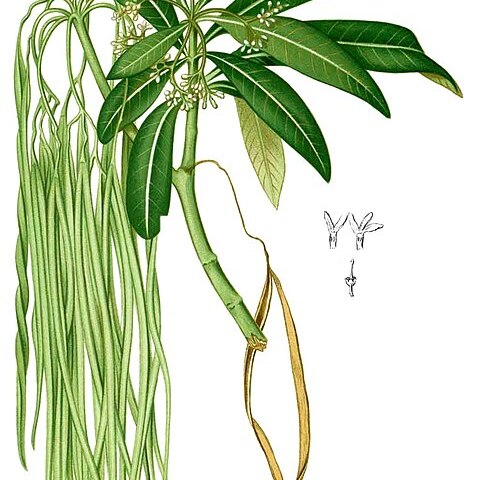Small or big tree (sometimes shrub) 3-30 m high, up to 90 cm dbh, sometimes with small buttresses. Bark smooth, scaly or longitudinally fissured, corky, grey, brownish or dark brown; inner bark yellowish or straw-coloured, hard, granular, without white latex. Branchlets glabrous or puberulous. Leaves in whorls of 3 or 4; petiole glabrous or puberulous, slender or rather stout, (0-)5-27 mm long, many minute colleters densely packed together in the axils; blade chartaceous or thinly coriaceous when dried, linear to obovate, 3-32 by (0.2-)1-12 cm, 1.8-16(-47.5) times as long as wide, apex acute, obtuse or shortly abruptly acuminate, acumen up to 10 mm long, base acute or decurrent onto the petiole, sometimes with slightly rounded base and then running down onto the petiole as a narrow wing, glabrous (rarely puberulous) above, glabrous or puberulous to velutinous beneath; 10-30(-40) pairs of secondary veins (rather obscure for the linear-form), forming an angle of 60-80(-90)° with the midrib, 2-15 mm from each other; tertiary venation reticulate, sometimes scalariform, mostly conspicuous beneath (or sometimes on both sides). Inflorescences 2.5-11 cm long, many-flowered; pedicels 1-3 mm long, puberulous or tomentose. Bracts and bracteoles scale-like, up to 1(-1.5) mm long, ovate or broadly ovate, acute or acuminate, ciliate, puberulous or pubescent outside, glabrous inside. Flowers fragrant. Sepals connate at the base for 0.3-1.2 mm, ovate, sometimes obovate or suborbicular, 1.1-3 by 1-1.8 mm, apex obtuse or rounded, sometimes mucronulate, erect, ciliate, pubescent outside, glabrous inside (less often laxly puberulous around the apex). Corolla lobes dextrorse; white, cream or yellow, 4-7.5 mm in the mature bud and forming an ovoid head, 1.2-3 by 0.8-1.5 mm, puberulous or pubescent outside; tube 3-5.5 mm long, 1-2 mm wide around the stamens; lobes suborbicular or ovate, 2-3.5 by 1.2-2.8 mm, 1-2.1 times as long as wide, ciliate, apex obtuse or rounded, pilose inside, auriculate at the base on the right side. Stamens inserted at 1.6-3.4 mm from the base; anthers ovate, 0.9-1.2 by 0.3-0.5 mm, acute, obtuse or sometimes mucronulate with a pointed tip. Pistil 1.9-3.8 mm long; ovary ovoid or broadly ovoid, 0.5-1 by 0.6-1 mm, of 2 carpels, glabrous, with a disk-like thickening at the base, 0.2-0.4 mm high; style 1-2.1 mm long; style head ovoid or funnelform 0.4-0.7 by 0.2-0.45 mm, with a minute cleft stigmoid apical part 0.1-0.2 mm high. Fruit a pair of follicles, (15-)20-50 cm by (2.5-)3-4 mm, glabrous. Seeds elliptic or narrowly so, sometimes ovate, 5-9 by 1.5-2.7 mm, dark brown, mostly blackish at the margin, pubescent on both sides, one end acuminate with an acumen up to 2.7 mm long (sometimes acute or cuneate), other end rounded or obtuse; longest cilia 6-13 mm long, becoming gradually shorter towards the margins.
More
Tree to 25 m high. Leaves opposite or 3-or 4-whorled; petiole 15–25 mm long; lamina lanceolate, elliptic or obovate, to 36 cm long, to 12.5 cm wide, cuneate, shortly acuminate, discolorous; secondary veins 18–20 each side of midrib, prominent, 3–18 mm apart; tertiary venation reticulate. Inflorescence to 11 cm long. Flowers 5–6 mm long, 3.5–5 mm diam.; pedicels 1.7–3 mm long. Sepals ovate, 1.5–2.2 mm long. Corolla white; tube 3.5–4.9 mm long, with dense external indumentum; lobes lanceolate-ovate, 1.5–2.6 mm long, with dense indumentum externally and internally. Fruit 20.5–40.3 cm long. Seeds oblong, 5–8 mm long; hairs 5–7 mm long.


